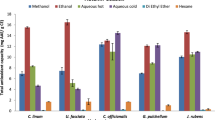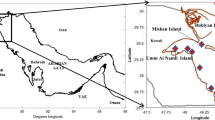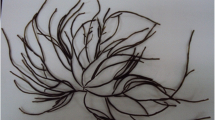Abstract
Glasswort (Salicornia herbacea L.) is a halophyte that grows normally in salt marshes and has been used as a seasoned vegetable. Physico-chemical properties, antioxidant, cytotoxic, and anti-inflammatory activities of water extracts from freshwater-cultivated (FWE) and naturally-grown (SWE) glasswort were investigated. Total phenolic and flavonoid contents of FWE were higher than for SWE. The salinity was higher in SWE. Radical scavenging activities and inhibitory effects against lipid peroxidation of FWE were more potent than for SWE. FWE also showed more potent cytotoxic effects with higher potency against cancer cells. FWE was effective for inhibition of protein expression of inducible nitric oxide synthase and cyclooxygenase-2 in lipopolysaccharide-stimulated RAW264.7 cells. Constituents in FWE were more active than in SWE, and freshwater-cultivated glasswort can be a useful dietary source with health benefits.
Similar content being viewed by others

References
Min JG, Lee DS, Kim TJ, Park JH, Cho TY, Park DI. Chemical composition of Salicornia herbacea L. J. Food Sci. Nutr. 7: 105–107 (2002)
Tite MS, Shortland A, Maniatis Y, Kavoussanaki D, Harris SA. The composition of the soda-rich and mixed alkali ashes used in the production of glass. J. Archaeol. Sci. 33: 1284–1292 (2006)
Rhee MH, Park HJ, Cho JY. Salicornia herbacea: Botanical, chemical and pharmacological review of halophyte marsh plant. J. Med. Plants Res. 3: 548–555 (2009)
Kim SH, Ryu DS, Lee MY, Kim KH, Kim YH, Lee DS. Anti-diabetic activity of polysaccharide from Salicornia herbacea. Microbiol. Biotechnol. Lett. 36: 43–48 (2008)
Kong CH, Kim YA, Kim MM, Park JS, Kim JA, Kim SK, Lee BJ, Nam TJ, Seo Y. Flavonoid glycosides isolated from Salicornia herbacea inhibit matrix metalloproteinase in HT1080 cells. Toxicol. in Vitro 22: 1742–1748 (2008)
Cha JY, Jeong JJ, Kim YT, Seo WS, Yang JS, Kim JS, Lee YS. Detection of chemical characteristics in hamcho (Salicornia herbacea L.) according to harvest periods. J. Life Sci. 16: 683–690 (2006)
Kim YA, Kong CS, Um YR, Lim SY, Yea SS, Seo Y. Evaluation of Salicornia herbacea as a potential antioxidant and anti-inflammatory agent. J. Med. Food 12: 661–668 (2009)
Ryu DS, Kim SH, Lee DS. Anti-proliferative effect of polysaccharides from Salicornia herbacea on induction of G2/M arrest and apoptosis in human colon cancer cells. J. Microbiol. Biotechnol. 19: 1482–1489 (2009)
Chung YC, Chun HK, Yang JY, Kim JY, Han EH, Kho YH, Jeong HG. Tungtungmadic acid, a novel antioxidant, from Salicornia herbacea. Arch. Pharm. Res. 28: 1122–1126 (2005)
Lee KY, Lee MH, Chang IY, Yoon SP, Lim DY, Jeon YJ. Macrophage activation by polysaccharide fraction isolated from Salicornia herbacea. J. Ethnopharmacol. 103: 372–378 (2006)
Park SH, Ko SK, Choi JG, Chung SH. Salicornia herbacea prevents high fat dietinduced hyperglycemia and hyperlipidemia in ICR mice. Arch. Pharm. Res. 29: 256–264 (2006)
Jo YC, Lee KS, Chon SM, Byun DS. Characteristics of growth and germination of Salicornia herbacea L. for the soil salinity and manure condition. Korean J. Med. Crop Sci. 10: 100–108 (2002)
Ventura Y, Sagi M. Halophyte crop cultivation: The case for Salicornia and Sarcocornia. Environ. Exp. Bot. 92: 144–153 (2013)
Kim YS, Huh MR, Park JC. Effects of culture media and seawater on growth and mineral concentrations in Glasswort (Salicornia herbacea). Korean J. Hortic. Sci. 19: 342–347 (2001)
Baik J, Chiang M. Effects of different soil on the growth of Salicornia herbacea. J. Bio-Environ. Control 20: 216–220 (2011)
Kang S, Kim D, Lee BH, Kim MR, Chiang M, Hong J. Antioxidant properties and cytotoxic effects of fractions from glasswort (Salicornia herbacea) seed extracts on human intestinal cells. Food Sci. Biotechnol. 20: 115–122 (2011)
Ambati RR, Ravi S, Vallikannan B, Gokare AR. Antioxidant activity of Botrycoccus braunii extract elucidated in vitro models. J. Agr. Food Chem. 54: 4593–4599 (2006)
Stohs SJ, Bagchi D. Oxidative mechanisms in the toxicity of metal ions. Free Radical Bio. Med. 18: 321–336 (1995)
Bogdan C. Nitric oxide and the immune response. Nat. Rev. Immunol. 2: 907–916 (2001)
Needleman P, Truk J, Jakschik BA, Morrison AR, Lefkowith JB. Arachidonic acid metabolism. Annu. Rev. Biochem. 55: 69–102 (1986)
Marnett LJ, DuBois RN. COX-2: A target for colon cancer prevention. Annu. Rev. Pharmacol. 42: 55–80 (2002)
Lin LL, Wartmann M, Lin AY, Knopf JL, Seth A, Davis RJ. cPLA2 is phosphorylated and activated by MAP kinase. Cell 72: 269–278 (1993)
Author information
Authors and Affiliations
Corresponding author
Rights and permissions
About this article
Cite this article
Kang, S., Kim, MR., Chiang, M. et al. Evaluation and comparison of functional properties of freshwater-cultivated glasswort (Salicornia herbacea L.) with naturally-grown glasswort. Food Sci Biotechnol 24, 2245–2250 (2015). https://doi.org/10.1007/s10068-015-0299-1
Received:
Revised:
Accepted:
Published:
Issue Date:
DOI: https://doi.org/10.1007/s10068-015-0299-1



